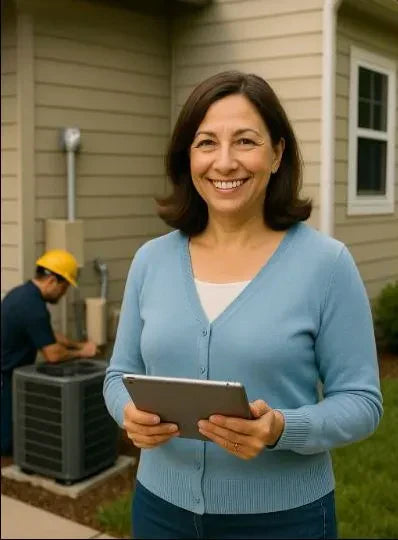Real Customer Stories & Case Studies with R32 Gas Furnaces
Sometimes the best way to understand the benefits of a product isn’t through technical specs or brochures—it’s through real customer stories. Numbers tell one part of the story, but hearing how families actually live with a system brings the details to life.
That’s why today we’re diving into real-world case studies of homeowners who upgraded to R32 Gas Furnaces. These stories cover comfort, energy savings, and lessons learned along the way.
1 | Why Customer Stories Matter
For most homeowners, replacing a gas furnace isn’t just another purchase—it’s an investment in their family’s safety, comfort, and financial future. Hearing real stories helps answer questions like:
-
Will this system actually lower my bills?
-
How will it perform in my climate?
-
Is the installation process stressful?
-
What’s it like living with an R32-compatible furnace?
2 | Case Study #1 – The Midwest Family Who Beat Rising Fuel Bills
Location: Minnesota
Home Size: 2,400 sq. ft.
Old System: 80% AFUE gas furnace (15 years old)
New System: 96% AFUE two-stage R32-compatible furnace
Challenge:
Winters in Minnesota are harsh, and the family’s old gas furnace struggled to keep up with the cold. Fuel bills were climbing to nearly $3,000 per winter, and uneven heating left bedrooms chilly.
Solution:
They upgraded to a high-efficiency, R32-compatible furnace with a two-stage burner and ECM blower.
Results:
-
Annual fuel bills dropped by 25% (~$750/year savings)
-
Even heating throughout the home, no more cold bedrooms
-
Eligible for $300 state rebate for efficiency upgrade
3 | Case Study #2 – The Texas Couple Who Wanted Quiet Comfort
Location: Dallas, TX
Home Size: 1,800 sq. ft. ranch
Old System: Oversized 120k BTU furnace
New System: Properly sized 80k BTU R32 Gas Furnace with variable-speed blower
Challenge:
The old furnace short-cycled constantly, creating noise and uneven comfort. It was also burning more gas than necessary.
Solution:
A Manual J load calculation accurately sized the new system, and duct sealing improved airflow (Midwest Energy Efficiency Alliance).
Results:
-
Energy bills down 20% annually
-
Noise level dropped from 75 dB to 58 dB
-
Better airflow = improved indoor air quality
4 | Case Study #3 – The Eco-Conscious Homeowner
Location: Portland, OR
Home Size: 1,500 sq. ft. bungalow
Old System: Electric baseboard heaters
New System: R32-compatible hybrid furnace + heat pump system
Challenge:
The homeowner wanted to reduce their carbon footprint and qualify for rebates.
Solution:
Installed an R32-ready dual-fuel system: gas furnace for extreme cold, heat pump for mild temps.
Results:
-
Energy bills cut by 30% ($600/year)
-
Reduced emissions footprint with R32 refrigerant
-
Qualified for $1,200 in rebates and federal tax credits (Energy Star)
5 | Case Study #4 – The Family Who Solved Humidity Problems
Location: Georgia
Home Size: 2,100 sq. ft.
Old System: Single-stage 80% AFUE furnace
New System: 95% AFUE modulating R32-compatible furnace
Challenge:
High humidity levels were causing discomfort and mold risks. The single-stage furnace wasn’t controlling airflow well.
Solution:
Installed a modulating R32 furnace with variable blower and whole-home dehumidifier.
Results:
-
Humidity levels stabilized at 45%
-
No more musty smell or condensation on windows
-
Energy savings of 18% annually
6 | Lessons from the Stories
Across these case studies, some patterns emerge:
-
Correct sizing matters: Oversized systems waste money and create comfort issues.
-
R32 compatibility is future-proof: Ensures compliance with refrigerant regulations.
-
AFUE rating impacts costs: Higher AFUE = real fuel savings (Energy Kinetics).
-
IAQ improves with modern systems: Advanced blowers and filtration improve air quality.
7 | Common Homeowner Questions
Q: Are R32 Gas Furnaces more expensive upfront?
A: Yes, slightly—but rebates and lower bills balance it out in 3–5 years.
Q: Do all homes need R32 compatibility?
A: If you have or plan to add central AC/heat pumps, yes—it’s the new standard refrigerant.
Q: What’s the average payback period?
A: Typically 3–7 years, depending on climate and fuel costs (DOE).
8 | Final Take
At the end of the day, technical specs only go so far. What really matters is how a gas furnace performs in real homes with real families.
From lower bills in Minnesota to quieter comfort in Texas, and eco-friendly upgrades in Oregon, the stories of R32 Gas Furnaces prove one thing: these systems are not just efficient—they make daily life better.
If you’re still unsure, ask yourself:
-
Do I want lower monthly bills?
-
Do I care about comfort and indoor air quality?
-
Do I want my system to be future-ready?
If the answer is “yes,” then an R32 gas furnace might be the smartest investment you make this decade.







